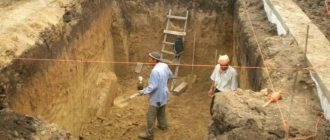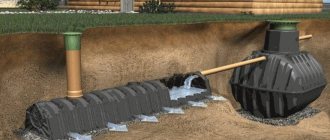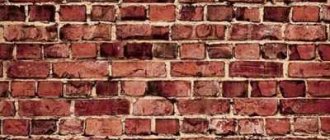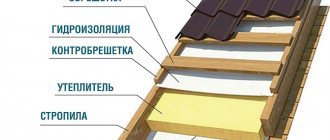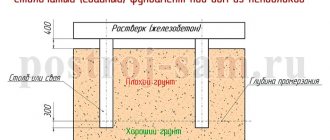It is necessary to distinguish between main and secondary issues, as well as pragmatic and aesthetic ones. As a rule, limited resources force us to turn to pragmatic issues as the main ones. Therefore, despite the importance of the aesthetic qualities of a house (its appearance and interiors), they can only be realized as a result of the successful solution of pragmatic issues. The latter include: the size of the structure and the composition of the premises, the materials used, the types of engineering systems, as well as the organization of design and construction, on which the final cost of the finished house also depends.
The importance of these issues is also determined by the fact that if the unsuccessful decoration of facades and interiors (and even the internal layout) can be redone if desired, then the structural part of the building is practically impossible to correct.
There is a lot that an architect can advise during the design process. But in his business, he focuses, first of all, on the client’s task, and if the customer himself does not know what he wants, then it will be difficult for the specialist to achieve a satisfactory result. Therefore, even before you start designing a house, you should answer several main questions.
How much money is needed for construction?
Funds, large or small, are usually still limited, and it is important to design a house that is feasible to build. The amount of funds will determine what size and from what materials the house can be built.
We can assume that 1 m2 of construction of an individual house made of heavy materials (ceramics, aerated concrete), taking into account finishing and the involvement of qualified builders, will cost on average 650 USD. e. Thus, a house with an area of about 100 m2 will cost about 65 thousand. That is, accordingly, a house of 150 m2 is about 90 thousand. e. At the same time, with an increase in the area of the house, the cost of 1 m2 decreases - by 15% when the area increases from 50 to 100 m2, and then less noticeably.
By choosing different options for materials, layout, technology, etc., the cost of construction can be reduced (or increased). The most important factors affecting the cost of a house are the material and length of the external walls, the area and material of the roofing, and the presence or absence of insulation.
They affect the cost and planning features of the building. The general rule is this: the more complex the shape and the more “decorations” on the facade, the more expensive the house. Simple facades will not only reduce construction costs, but also increase the energy efficiency of housing during operation.
The price of construction largely reflects the quality of the home. It is determined, first of all, by durability, environmental friendliness, and ease of operation. You can build a smaller house, using only the highest quality materials, or you can build a larger one, using inexpensive, but less durable ones.
Unforeseen expenses (up to 15%) should definitely be taken into account, but it is important to organize the work in such a way as to minimize them.
The cost of construction and installation work averages 40% of the total construction cost, and the more qualified the team, the more expensive, as a rule, its services
The influence of architecture on the value of a home
Increase the cost:
- the presence of bay windows, balconies
- presence of a basement
- a large number of small rooms
- availability of rooms with second light
- high ceilings
- use of non-standard designs
- complex shape and steep roof slope.
Reduce cost:
- attic floor instead of a full second floor
- a large number of windows
- compactness, building shape close to square, absence of protrusions and recesses on the facades
- layout with a minimum of internal walls.
Sand-lime and ceramic bricks - modern technologies for building houses
Sand-lime brick consists of lime, sand and some other additives. Solid brick and brick with cavities become materials that guarantee protection from moisture, as well as low thermal conductivity. Ceramic becomes ideal when you strive to achieve a solid and environmentally friendly building. Thanks to the various shapes and number of holes inside, the highest thermal insulation level is achieved. The material is used both for the main masonry of walls and as cladding. In this case, materials must be carefully selected for each case. For example, the slightest chips or damage are unacceptable for the facing option.
Due to the fact that traditional brick is considered a fairly cold and moisture-accumulating material, experts have long been looking for even more modern technologies for building houses that would cover the shortcomings of the materials we are used to.
How much time?
The duration of construction is determined by technology - different methods have their own deadlines. Thus, a frame or wooden house (and any other prefabricated element) can be built much faster than a brick one. Rapid construction involves an almost one-time investment of funds for the purchase of a house kit and subsequent installation.
But in most cases, costs are distributed in stages, and there is a clear pattern here - the longer the construction process stretches, the more expensive the house costs. Therefore, to save money, it is important to ensure timely receipt of funds for construction in accordance with technological processes.
If you urgently need to quickly build a house, it is better to choose prefabricated technology, and if you build from ceramics or aerated concrete, then you need to calculate the financing in such a way as to ensure the possibility of moving in during the construction season (from spring to winter), that is, to bring the house at least to the stage of interior decoration .
Knowing your financial capabilities and the schedule for receipt of funds, you can choose the best option for the project and organization of construction. In this case, it is advisable to rely on reliable funds so that construction does not have to be frozen indefinitely - this will negatively affect the volume already built and, ultimately, increase the cost of the house. It is better to arrange smaller housing, but ensure uninterrupted financing of construction from start to finish.
Since construction from stone materials is slower, money can be invested gradually
A house made of lightweight materials can be built quickly, and you will have to pay for the entire set at once
Construction stages and their average cost (in%)
15% zero cycle - construction of the foundation and basement (if designed). After finishing the work, wait a month or more before erecting the walls. During wintering, the structures are protected from atmospheric influences.
35% general construction work - erection of walls and roof (it is not necessary to install windows at this stage). External and internal walls are erected simultaneously - this ensures an even load on the foundation. It is necessary to keep within the vertical period until autumn. After this, the house can overwinter.
15% windows, doors, insulation - having chosen high-quality products, it is important to carry out correct installation using all the necessary components.
15% wiring and installation of communications, laying pipes, installation of boiler equipment and installation of plumbing. System testing is required
20% interior finishing work - in an insulated and equipped house, finishing work can be extended to any time
Construction
The actual construction of a residential multi-storey building takes place in several stages. Let's look at these stages in detail:
Preparing the site for construction
The developer carries out preliminary work that allows the construction of the facility to begin. This includes fencing the area to prevent entry by unauthorized persons, clearing the land area of trees, structures or buildings (if any), as well as re-equipping utility networks that interfere with construction activities.
At the same stage, the developer organizes routes for transport access, thinks through the nuances of laying communications, provides systems for protection from rainwater, and installs household and administrative premises.
Marking the axes of the house
This stage of construction is extremely important and requires accurate calculations, as well as careful verification of the results obtained. Even small deviations can lead to a number of consequences that cannot be corrected. In the marking process, new types of measuring instruments are used, which are highly accurate.
Excavation
A special feature of this stage is the preparation of the pit for subsequent laying of the foundation. Work is also underway to create trenches for supplying communications. When building an apartment building with a large number of floors, the volume of earthworks is large, so special equipment is used - excavators and bulldozers.
Laying the foundation
At the heart of any multi-storey structure is a foundation, the quality of which determines the reliability, strength and, accordingly, the lifespan of the finished building. The base takes on the greatest load, so when drawing up a project, maximum attention is paid to it.
The type of foundation used depends on the soil. For example, when constructing a multi-story building, it may be necessary to add sand or gravel. The main work at this stage is pouring concrete capable of supporting a high-rise structure.
Construction of external walls
The duration and complexity of this stage depends on the chosen technology. There are plenty of options - erecting a building from brick, using reinforced concrete panels or building using monolithic technology. The latter option is in greatest demand due to its simplicity, reliability and high speed of construction.
See also: Development of design documentation for construction
Communications supply
As noted above, trenches for communications are prepared at the excavation stage. At this stage, gas, water and electricity supply elements are laid. Work on the supply of sewerage and other utility networks is also carried out here.
Roof arrangement
The volume and complexity of the work depends on the type of roof chosen. Modern multi-storey buildings often have a usable type of roof with the possibility of arranging a winter garden at the top. This, in turn, increases the cost of construction.
Final stages
At the final stage, the following work is performed:
- Creation of internal partitions - dividing the house into apartments, taking into account the previously drawn up project, as well as equipping the building with elevators.
- Installation of windows and installation of metal doors in the apartments of future residents.
- Arrangement of internal communications - installation of electrical wiring, sewerage, water and gas supply systems, installation of water and gas meters.
- Floor screed. During the work process, a sand-concrete composition is used, and after pouring, the surface is leveled.
- Interior finishing can be rough or finishing. Many construction companies sell housing with rough finishing, which allows them to reduce the cost of apartments. If the developer carries out a full scope of work, you can immediately move into the resulting property, but the price will be higher.
- Exterior finishing - façade treatment, as well as renovation of common areas. When selling apartments with rough finishing, common areas (hall, entrance, staircases) must be completely ready for use.
What area?
Depending on the available funds, you can determine the approximate area of the house. But in addition to financial capabilities, you should be guided by the composition and lifestyle of the family, as well as common sense.
Research shows that an area of 30 m2 per person in a residential building is enough to feel absolutely comfortable. This means that for a family of 5 people a house with an area of 150 m2 is enough. With a larger area, there is a possibility that some of the premises will be empty. A smaller area may affect the level of comfort. It largely depends on the layout: the availability of all the necessary premises, their convenient interconnection, and rational use of space.
When determining the area of the house, it is worth thinking about its economical operation. All rooms, even those that are not in use, will have to be heated, and cleaning extra square meters will take time and effort.
The size of the building must be correlated with the size of the site. If the plot is small, then a large house will occupy the bulk of the territory. This is hardly advisable: in the warm season, a landscaped area is no less important than a house.
The composition and dimensions of the premises can be determined taking into account the standard requirements for a residential building:
- It is important to have day and night zones. The day room includes the hallway, living room, kitchen, dining room, and bathroom; the night room includes bedrooms and bathrooms.
- The day zone is located closer to the entrance to the house, the night zone is located away from the hustle and bustle, usually on the second floor.
- The area of the daytime area should be larger, the more people live in the house (40-60 m2 for 3-5 people). If the rooms or part of them are combined (for example, a living room with an entrance hall, a kitchen and dining room with a living room, etc.), then the space will seem more spacious
- The required area of the sleeping area depends on the number of bedrooms (50-70 m2 for 3-5 people). The area of each room can be 10-20 m2, but the most important thing is that each family member is provided with a personal room, no matter how small. The number of bedrooms should ideally be equal to the number of residents, with the exception of only the master bedroom, which is designed for two.
- In a house where more than three people live, there must be at least two bathrooms (5-10 m2) and one bathroom for two bedrooms
- For complete comfort in the house you need a terrace (10-15 m2). In addition, part of the area (10-20 m2) will be used for communication areas (corridors, halls, stairs) and utility rooms (storage rooms, dressing rooms).
The larger the plot, the larger the house can be. For a good rest, it is advisable to leave at least 4-5 acres free from development
It is better not to include the garage in the volume of the house, but to make it attached or separate. Minimum garage area for one car -18 m2
How many floors?
The compact volume of the house, close to a cube, has advantages in construction costs, energy efficiency and rational connections between rooms.
That's why:
- a house with an area of about 100 m2 can be one-story. It is easier to construct and is especially convenient for older people
- If a larger area is required, in order not to “clutter up” the site, it is better to build a house on two levels. But bedrooms intended for elderly people and a guest room are better located on the ground floor
- a three-story house is rational if the plot is too small. Constantly moving up the stairs takes a lot of effort, so on higher floors it is better to locate rooms that are used less frequently or where privacy is needed
Should the second floor of the house be an attic or a full one?
In the southern regions of Ukraine, a full second floor with an attic is preferable, since it is easier to provide coolness in it in the summer. In these regions, you can also make a usable flat roof (and if the area is small, thus increasing the area for outdoor recreation).
For houses in other regions, when choosing a solution, it is worth considering the features of the attic:
- in the attic the volume of air is less than in a room of normal height, so it is important to ensure good ventilation
- the attic area is smaller than a full floor
- The installation of an attic requires highly qualified builders.
Experience shows that when installing an attic instead of a second floor, the cost of the house is reduced, but only slightly, since the design of the attic roof is more complex than that of the attic. The advantage of an attic house is noticeable during operation: its heating requires lower costs compared to a two-story building.
Making a basement or ground floor in your house?
This issue is difficult to solve without knowing the hydrogeological features of the site, since with high groundwater, the basement will be unreasonably expensive. If water leaks into it, there will be dampness throughout the house. It is better to make the final decision in consultation with a specialist.
When is a basement appropriate?
- The plot is small and it is undesirable to have a large building area. Then in the basement you can place utility rooms, a workshop, a sauna
- The house is on a slope and the ground floor comes naturally. It is convenient to place a garage, utility rooms, and sometimes part of the day area.
- It is supposed to store certain items in the house, a large workshop is required, and there is a desire to make a swimming pool.
The second floor is larger in area than the attic, in addition, due to the full height of the ceilings, there is more air volume there
What is the most expensive thing in building a house? How much does it cost to build a private house?
How much does it cost to build a house? This question interests all people planning to build a building. Very often the problem of lack of housing space arises, especially among apartment residents. Each person solves this situation in his own way, based on financial and physical capabilities. Most often, owners decide to build a country house, since purchasing a larger apartment is too expensive. For a private house, there are a large number of construction options, where you can both save money and create a universal type of construction. In our article we will look at how much it costs to build a house yourself.
Cost and price order
The first thing you need to do is decide on the site where to build the house
The price indicator for laying a wall depends primarily on the technology of construction work. The cost of a house wall depends on the type of masonry. The first thing you need to do is decide on the site where to build the house. Everyone knows the fact that the further from the city, the cheaper the land will be. So in the suburbs it will cost 1 million to build a building, and 50 km from the city for 300 thousand rubles.
The price of a plot is determined by the influence of the location of roads relative to it, the presence of a gas pipeline, sewerage and other sewerage systems. Once you have decided on the choice of location, you can decide with the developer what kind of house can be built and how much money is needed? Most owners still believe that it is more economical to buy a ready-made building than to build it yourself. Let's find out if this is true?
What wall material?
The main structural elements of a house are the foundation, walls, ceilings. They can be made from light (based on wood and metal) or heavy (ceramics, concrete) materials. The most significant factor for the quality and cost of a home is the material of the external walls. The general requirements for walls are as follows: strength, provision of sufficient heat and sound insulation.
Houses with walls made of ceramic and concrete materials have large wall thicknesses, are built, as a rule, from small-piece materials (the larger the size of the block, the faster); during construction, technological breaks are required for the concrete to harden and shrinkage of the structures. Sometimes additional insulation is necessary. In houses with light walls, most of the volume of structures is insulation (mineral wool or expanded polystyrene, which are cheaper than construction materials). Buildings can be assembled from ready-made factory-produced elements, which results in low construction labor intensity.
To select wall material, it is important to consider the following parameters:
- a house made of heavy materials will require the use of a deep strip foundation or foundation slab. For a building made of lightweight materials, you can use a more economical columnar foundation
- For the floors of a house made of heavy materials, you can use both reinforced concrete (slabs or monolith) and wooden beams. In light buildings, floors can only be made of wood (or metal, if the house is based on metal structures);
- heavy materials are designed to last “for centuries”. Lungs have a limited service life depending on their composition and workmanship;
- a house can be built from light materials much faster than from heavy ones; and houses made from lightweight materials are generally cheaper to build and in many cases have a fixed cost
- houses made of lightweight materials are built without the use of “wet” processes, which contributes to the preservation of the site. The construction of housing with walls made of heavy materials will require a large area for storing materials, preparing mortar, etc.
- in a house with walls made of heavy materials, the indoor microclimate is inert and stable. Buildings made of lightweight materials heat up and cool down faster.
There are no bad materials or structural systems, there is only their use for other purposes and without due professionalism
With the same plan area, the smaller thickness of the walls of a house made of light structures compared to a house made of heavy materials gives an increase in the area of the premises (8-10 m2 for one floor)
Modern materials for building a house. House made of stone
By stone we mean the use of boulder, brick, concrete (monolith), foam concrete and aerated concrete.
What is the difference between brick and foam concrete? Bricks are more durable and can be used to build a high-rise building. Foam concrete is not suitable for high-rise construction; it is used in two- and three-story cottages.
He is building a private house out of brick, this is an excess, although it will not make things worse. Bricks, unlike foam concrete, are a hygroscopic material and absorb water.
You can easily verify this by simply throwing bricks and foam concrete into the water and splitting these objects after 7 days. The brick will be completely wet inside, unlike foam concrete.
There are also aerated concrete blocks. Not to be confused with foam concrete! In appearance, the difference is practically unnoticeable, but aerated concrete blocks are made differently. You can determine where which material is by getting them wet. A block of aerated concrete will immediately absorb all the water, like a sponge. If an aerated concrete block gets wet, it will never become dry.
What roof?
The roof is one of the most important elements of a house, affecting its reliability, cost and aesthetic appeal. Its shape depends on the building plan. If the walls have numerous projections, then the roof becomes more complicated. With a complex structure, a lot of waste wood and roofing materials arise, the cost of this element of the house increases (and there may be leaks in places of kinks). In addition, the higher the roof slope, the larger its area and the higher the price.
Therefore, it is better to build the aesthetics of the roof on the harmonious proportions and attractiveness of the roofing material, which is possible even with a simple form, if the roof matches the house in color and style, and the material is carefully laid. The choice of material depends on the specific requirements for the roof. The main one is to provide protection from precipitation - all types of coatings perform. Thermal insulation and sound insulation in the attic roof is provided by insulation. Other important requirements include durability, ease and speed of installation, and low cost. Roofing materials vary in these qualities.
Roofing coverings come in sheets and pieces. Sheet roofing includes metal tiles, seam roofing, and slate. It is convenient, quick and profitable (since the waste is minimal) to be laid on simple roofs, with slopes close to a rectangle. These materials are the most economical and lightweight. You can use rare lathing under them.
Piece include bitumen and natural tiles (ceramic or cement-sand). They can easily cover not only simple but also complex surfaces. But installation is quite labor-intensive and requires professional skills. Shingles prices vary significantly. Bitumen roofing can be classified as an economical material (although the price range is large), but its installation requires the use of continuous sheathing (which will affect the overall cost of the roof).
The most expensive material is natural tiles (ceramic tiles are twice as expensive as cement-sand tiles), but they have an almost unlimited service life. Due to the heaviness of the tiles, a more powerful rafter system is required under them than for other types of roofs.
Sheet materials are lighter in weight and not too difficult to install
Working with piece roofing materials is more labor-intensive and requires knowledge of a large number of nuances, so it is better to entrust it to professionals
The simpler the better
When designing a house, the architect offers the client options and shows him magazines to find out his preferences. It’s good if the customer comes to the architect with his own illustration, which shows the style and other features of the house. But it’s even better if the future homeowner puts his wishes on paper. Thinking through and formulating these main points in writing helps you clearly understand your needs and convey them to a specialist. It is also important that the written requirements for the house are agreed upon by all family members.
The simpler the house, the more reliable it is. Therefore, in your plans you should not strive for exclusive solutions, be guided by pictures from foreign magazines and impressions received in distant countries. The house must comply with local climatic conditions and take into account the level of the domestic construction industry. For example, a Japanese-style house with large windows will cost more and will certainly be less convenient to use than a traditional house with window sizes in accordance with the standards - 1/5 of the floor area. An “expressive” roof will be expensive, and in the future it may leak at kinks. Having conceived a “family estate”, you should not immediately build a large house - it is better to have a large plot and build it up as needed.
Preparation
It is at this stage that important issues will need to be resolved - choosing a location for construction, calculating the budget, selecting a project, obtaining permission for construction and choosing a contractor. All issues are of equal importance, and you will have to pay enough attention to everything.
Purchase of land
When selecting and purchasing a plot of land for a new home, you need to pay attention to practical and legal nuances. The procedure will be accompanied by the preparation of a large number of documents, and therefore it would be more advisable to involve a realtor or lawyer. It will not be possible to figure out how to build a house without a painstaking inspection of the site where the work will be done, and ideally, everything will start with the search for land for construction. The fact is that the convenience of future life fully depends on the location of the site, and when choosing the latter you need to be guided by certain criteria:
- Features of the site - take into account not just the relief, but also the area. A site on a slope needs additional financial investments for excavation and leveling work, and building retaining walls.
- Documents of the seller (owner) - it is important to ensure the authenticity and accuracy of the filling.
- Location - it is important to take into account the proximity to civilization, the quality of access roads, the environmental situation (harmful industries located nearby). It is important to find out if there are swamps, wastewater treatment facilities or a landfill nearby.
- Infrastructure - assess the availability of engineering communications (you will receive detailed information from the management company).
- Possible additional expenses - there is a possibility that the site has dilapidated capital buildings that are subject to demolition, or high-lying groundwater, which means that an effective drainage system will need to be installed.
You can obtain this and other information from the owners of neighboring land plots, as well as from the city administration. Experts with extensive experience recommend making a request to special institutions about the authority to connect to existing engineering networks. Otherwise, an unexpected ban can become a serious problem.
When the place to build the house has been finally selected, take steps that will make the work easier, and you will learn how to start building a house correctly:
- They carry out geodetic and geological surveys, as well as topographic surveys of the area. The result will be information about the composition of the soil and the depth of the water, which helps to adapt the foundation of a typical project to certain conditions. If construction has begun on the ground, you will need to tie into the foundation that already exists, and possibly strengthen it.
- After acquisition, the plot must be fenced.
- In order not to pollute most of the soil with construction waste, it is necessary to determine a place for storing waste, mixing concrete, burning waste, and also access to construction equipment.
How to minimize losses when building a house, watch the video.
What to build a house from
The choice of good materials is a topic for another discussion. Any material, be it wood, brick, aerated concrete, has certain properties. Such qualities can manifest themselves both on the positive and negative side, and this depends on the context of application. When choosing a material, the deciding factors will be local conditions (terrain or climate) and financial capabilities. The latter often interfere with making a home reliable, comfortable and at the same time environmentally friendly. It is also necessary to remember that every house needs thoughtful insulation, a reliable roof and modern engineering-type support. In general, it will be faster and cheaper to build block and frame houses. It takes the least amount of time (a couple of days) to install a modular house, but this option is not the most budget-friendly.
Construction costs
The desire to save is quite understandable and does not justify itself when building a house, because most often it leads to increased costs in the future. Stage-by-stage construction of a house requires a detailed calculation of the estimate, and it is better to draw it up together with the foreman. Once the roof and walls are built, the cost of building engineering may seem very high, but it is not recommended to reduce them without a good reason.
How to heat?
A well-thought-out heating solution will help you save significant money on the operation of your home in the future. Currently, the most common heating systems use (in order of increasing cost) gas, electricity, solid (coal, wood) or liquid fuel (diesel). But energy prices are rising, their relative costs are changing, and it is not known for sure what will be more profitable in ten years.
Gas is still the most affordable source of heat - heating a unit area of a house using a gas boiler will be the most economical option. If gas is already supplied to the site on which the house is being built, then this advantage is worth using. But gasification of the building itself - obtaining permission and connecting to a gas pipe - will still cost a lot.
If there is no gas on the site, the choice often falls on electricity. The advantage of electric heating is environmental friendliness, wide possibilities for choosing a heating system (in addition to the boiler, you can use heated floors, radiant panels, etc.), convenient adjustment. Installing an electric boiler is much cheaper than installing a gas one. Using a night tariff will allow you to pay no more for electricity than for gas (but you will have to buy a special meter).
of a solid fuel boiler is becoming increasingly popular . Modern models operate with high efficiency, are equipped with automation, and their installation does not require the same costs as in the case of gas equipment.
There are also combination boilers that operate on two types of fuel. However, due to their high cost, it is more rational to use them for large houses. But it is desirable to have an alternative source of heating: for example, in addition to a gas boiler, you can install an electric heated floor on the ground floor of the house. He can help out in the offseason.
Solar collectors are promising for Ukraine - even in the northern regions, heating water using free solar energy allows you to refuse gas or electricity in the summer
The advantage of a solid fuel boiler is the ability to burn everything that burns, including various wastes
How to drain waste?
Poor sewerage can cause a lot of trouble for owners. If the village in which the house is being built has a sewer system, then connection to local networks is mandatory. If not, then the developer has a choice: install a septic tank or build a local treatment facility (LTP). This issue must be resolved already at the stage of developing the general plan of the site, since for the VOC or a reservoir with wastewater, a place should be chosen at a certain distance from the house (no closer than 5 m from the windows and entrance doors and no less than 3 m from the border with the neighboring plot). For a treatment plant with filter drainage, an area of at least 30 m must be left free of trees.
When choosing a sewerage system, you need to consider the following factors:
- a septic tank will require less space than a sewage treatment plant
- installing a septic tank is cheaper than a treatment plant, but it will be more expensive to operate
- It is better to install a septic tank if there is little drainage in the house (few people live, the presence of people is not constant). The volume of a septic tank, designed to collect wastewater for 2 weeks for a family of 4 people, is 8 m3. Local cleaning is more effective if there are many people living in the house. It will eliminate the hassle and expense of regularly emptying the septic tank.
- When using a septic tank, you can use household chemicals without restrictions, while for local cleaning, the use of a number of substances is prohibited.
Types of house construction technologies
Everyone knows about classical building construction technologies. The main material is wood. Since ancient times, huts have been built in which households could breathe easily; the structure was completely environmentally friendly, did not require additional insulation, and had an excellent microclimate. A more modern option today is timber. But along with other offers on the market, it fades, because easy flammability and possible insect damage reduce its relevance. In search of a more durable and reliable technology for building houses, many choose brick.
A brick building can last up to 150 years, overcoming heat, frost, rain and hail. The technology has been known for a long time, so all the nuances are clearly worked out to the smallest detail. The only important thing is to find an experienced professional who is now just a phone call away from you. InnovaStroy is ready to offer modern interpretations of the familiar brick.
How to find performers?
An unsuccessful choice of performers can ruin the entire plan. Approaches to attracting builders may be different. In most cases, general construction, finishing and engineering work is performed by various teams, which the customer consistently invites to his site. Specialists in general construction work should be selected with particular responsibility.
There are several options available:
- involvement of several specialized teams: specialists in foundation construction, wall construction, roofers, window and door installers. It is important not to change the team during one working stage, so that responsibility for what is done lies with strictly defined persons;
- attracting a large construction company that can carry out all the work, or at least general construction work. If such a company has good recommendations, then concluding an agreement with it will be the most reliable option. However, the work of the company's qualified specialists (as well as the maintenance of its management staff) usually results in higher construction fees than for small teams
- If a frame, wooden or other house was designed by a specialized design and construction company, then it is best to entrust the construction to it. As a rule, such companies work efficiently, as they are interested in expanding the circle of customers. Finishing and engineering work can be safely entrusted to individual specialists or specialized teams. And in any case, when choosing builders, you must be guided by recommendations and customer reviews.
You should not take on the most critical stages of work on your own - laying foundations, erecting walls, laying roofs, installing insulation, etc.
